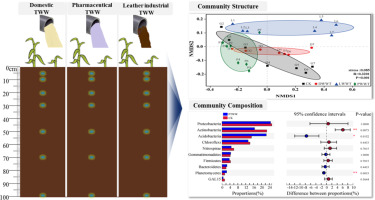Science of the Total Environment ( IF 8.2 ) Pub Date : 2019-06-14 , DOI: 10.1016/j.scitotenv.2019.06.138 Qiuling Dang , Wenbing Tan , Xinyu Zhao , Dan Li , Yanping Li , Tianxue Yang , Renfei Li , Guofeng Zu , Beidou Xi

|
Irrigation with treated wastewater (TWW) has become a prevailing agricultural practice due to the scarcity of fresh water resources, which may have a significant impact on the microbial communities that are critical to many biogeochemical processes in soils. However, it is unclear whether there are links between soil microbial responses to long-term irrigation with different sources of wastewater and soil depth. Here we assess the influence of treated domestic (DTWW), leather industry (LTWW) and pharmaceutical (PTWW) wastewater on microbial communities in vertical soil profiles using high-throughput sequencing based on 16S rRNA and internal transcribed spacer (ITS) gene profiling. We found that microbial α-diversity in the vertical profiles of soils was significantly influenced by TWW irrigation. Bacteria and fungi in different soil depths showed distinct responses to TWW; irrigation with TWW markedly increased abundance of bacterial OTUs and inhibited abundance of fungal OTUs. β-diversity analysis showed that the effect of TWW irrigation on microbial communities was greater than the effect of soil depth, and microbes in subsurface soil were more sensitive to different sources of irrigation water. We also found that, based on β-diversity analysis, irrigation with treated industrial wastewater, including LTWW and PTWW, had a greater impact on microbial community structures than DTWW. TWW irrigation significantly affected the composition of indigenous soil microbial communities at different depths and might introduce exogenous microbes into the soil environment. Our work explicitly demonstrates the vertical responses of bacterial and fungal communities in soils to irrigation with TWW from different sources, which can provides insights into the microbial-dominated geochemical processes from the perspective of the entire soil profile under the context of wastewater irrigation.
中文翻译:

将土壤中微生物群落结构对长期污水灌溉和土壤深度的响应联系起来
由于淡水资源的匮乏,用处理过的废水(TWW)灌溉已成为一种普遍的农业实践,这可能会对微生物群落产生重大影响,而微生物群落对于土壤中许多生物地球化学过程至关重要。但是,目前尚不清楚在废水来源不同的土壤对长期灌溉的微生物响应与土壤深度之间是否存在联系。在这里,我们使用基于16S rRNA和内部转录间隔子(ITS)基因谱的高通量测序方法,评估了处理后的生活用水(DTWW),皮革工业(LTWW)和制药业(PTWW)废水对垂直土壤剖面中微生物群落的影响。我们发现,土壤的垂直剖面中的微生物α多样性受到TWW灌溉的显着影响。不同土壤深度的细菌和真菌对TWW的响应不同。TWW灌溉显着增加了细菌OTU的丰度,并抑制了真菌OTU的丰度。β多样性分析表明,TWW灌溉对微生物群落的影响大于土壤深度的影响,地下土壤中的微生物对不同灌溉水源更敏感。我们还发现,基于β多样性分析,与DTWW相比,用经过处理的工业废水(包括LTWW和PTWW)进行灌溉对微生物群落结构的影响更大。TWW灌溉显着影响了不同深度的土著土壤微生物群落的组成,并可能将外源微生物引入土壤环境。































 京公网安备 11010802027423号
京公网安备 11010802027423号